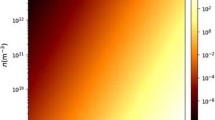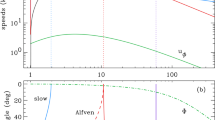Abstract
Recent SOHO/UVCS observations indicate that the perpendicular proton and ion temperatures are much larger than electron temperatures. In the present study we simulate numerically the solar wind flow in a coronal hole with the two-fluid approach. We investigate the effects of electron and proton temperatures on the solar wind acceleration by nonlinear waves. In the model the nonlinear waves are generated by Alfvén waves with frequencies in the 10-3 Hz range, driven at the base of the coronal hole. The resulting electron and proton flow profile exhibits density and velocity fluctuations. The fluctuations may steepen into shocks as they propagate away from the sun. We calculate the effective proton temperature by combining the thermal and wave velocity of the protons, and find qualitative agreement with the proton kinetic temperature increase with height deduced from the UVCS Ly-α observations by Kohl et al. (1998).
Similar content being viewed by others
References
Kohl, J. L., et al.: 1998, Astrophys. J, 501, 127.
Ofman, L., and Davila, J. M.: 1997a, Astrophys. J., 476, 357.
Ofman, L., and Davila, J. M.: 1997b, Astrophys. J., 476, L51.
Ofman, L., and Davila, J. M.: 1998, J. Geophys. Res., 103, 23677.
Parker, E. N.: 1963, Interplanetary Dynamical Processes, (New York: Interscience).
Steinolfson, R. S., and Nakagawa, Y.: 1976, Astrophys. J., 207, 300.
Author information
Authors and Affiliations
Rights and permissions
About this article
Cite this article
Davila, J.M., Ofman, L. Two-fluid 2.5D MHD Simulations of the Fast Solar Wind in Coronal Holes and the Relation to UVCS Observations. Space Science Reviews 87, 165–168 (1999). https://doi.org/10.1023/A:1005155209202
Issue Date:
DOI: https://doi.org/10.1023/A:1005155209202




